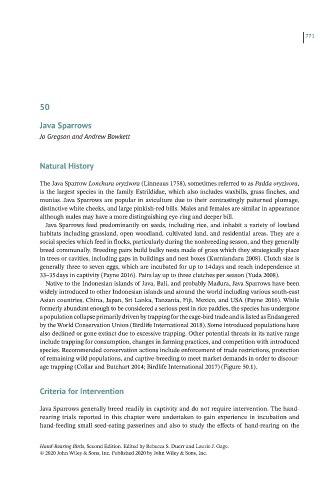Page 768 - Hand rearing birds second
P. 768
771
50
JavaSparrows
Jo Gregson and Andrew Bowkett
Natural History
The Java Sparrow Lonchura oryzivora (Linneaus 1758), sometimes referred to as Padda oryzivora,
is the largest species in the family Estrildidae, which also includes waxbills, grass finches, and
munias. Java Sparrows are popular in aviculture due to their contrastingly patterned plumage,
distinctive white cheeks, and large pinkish‐red bills. Males and females are similar in appearance
although males may have a more distinguishing eye‐ring and deeper bill.
Java Sparrows feed predominantly on seeds, including rice, and inhabit a variety of lowland
habitats including grassland, open woodland, cultivated land, and residential areas. They are a
social species which feed in flocks, particularly during the nonbreeding season, and they generally
breed communally. Breeding pairs build bulky nests made of grass which they strategically place
in trees or cavities, including gaps in buildings and nest boxes (Kurniandaru 2008). Clutch size is
generally three to seven eggs, which are incubated for up to 14 days and reach independence at
33–35 days in captivity (Payne 2016). Pairs lay up to three clutches per season (Yuda 2008).
Native to the Indonesian islands of Java, Bali, and probably Madura, Java Sparrows have been
widely introduced to other Indonesian islands and around the world including various south‐east
Asian countries, China, Japan, Sri Lanka, Tanzania, Fiji, Mexico, and USA (Payne 2016). While
formerly abundant enough to be considered a serious pest in rice paddies, the species has undergone
a population collapse primarily driven by trapping for the cage‐bird trade and is listed as Endangered
by the World Conservation Union (Birdlife International 2018). Some introduced populations have
also declined or gone extinct due to excessive trapping. Other potential threats in its native range
include trapping for consumption, changes in farming practices, and competition with introduced
species. Recommended conservation actions include enforcement of trade restrictions, protection
of remaining wild populations, and captive‐breeding to meet market demands in order to discour-
age trapping (Collar and Butchart 2014; Birdlife International 2017) (Figure 50.1).
Criteriafor Intervention
Java Sparrows generally breed readily in captivity and do not require intervention. The hand‐
rearing trials reported in this chapter were undertaken to gain experience in incubation and
hand‐feeding small seed‐eating passerines and also to study the effects of hand‐rearing on the
Hand-Rearing Birds, Second Edition. Edited by Rebecca S. Duerr and Laurie J. Gage.
© 2020 John Wiley & Sons, Inc. Published 2020 by John Wiley & Sons, Inc.

